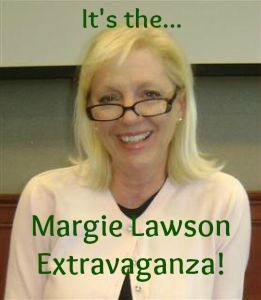Whoo boy, do I have a treat for you today. The lovely Melinda Collins recently returned from an Immersion Master Class with Margie Lawson, and she’s here today to share her experience.
I’m playing this cool now, but it was a different story earlier. When I heard Melinda was going to a weekend-long writer’s retreat, I’ll admit to a pang of jealousy. When I heard this retreat was going to be with the amazing Margie Lawson, I begged her to stuff me in her suitcase and take me with her. *sigh* But I was too tall.
So we get the next best thing, a Margie Lawson/Melinda Collins extravaganza! I have Part One of Melinda’s post here. Part Two is with Angela Ackerman at The Bookshelf Muse blog. And Margie Lawson herself is at Melinda’s blog.
And… And! There’s a giveaway at each of the three posts! Woo hoo!
Read on for the details and let’s get this extravaganza started. Take it away, Melinda…
*****
Immersion Master Class with Margie Lawson: The Experience, The Takeaways, The Lessons – Part One
Thank you, Jami, for inviting me over today to talk about my recent experience in Colorado with the wonderful, talented, writerly genius, Margie Lawson, and her Immersion Master Class!
The Experience
Ever had one of those energizing, eye-opening, and exciting experiences that feels like a once in a lifetime opportunity? Well that’s what Immersion Master Class was like – only it’s also a career-changing, confidence-boosting experience as well!
The kinship between the writers in the class began the moment we set foot in Denver. We each met Margie at the arrivals entrance and were literally, instantly welcomed with open arms. Margie and two classmates were there and waiting for me, and there were hugs all around (even though we’d never actually met before). The special kinship between every one of us was already there before we set eyes on one another because of the shared lessons, enthusiasm, and dedication we each had for our writing craft.
Once we picked up the last of our airport-arrival-buddies – whom we also welcomed with open arms – we trekked from Denver to Margie’s home all the way up a mountain where, unless you had a particular cell carrier, cell service was nonexistent – which is a good thing! Who needs the distraction of a cell phone when you’re there to work your butt off and learn, right? *wink*
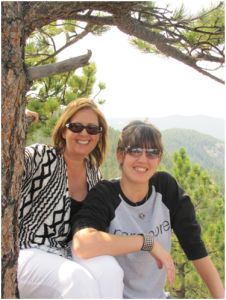
The instant we sat down for dinner on that first night (one other classmate was already there, my editing partner, Sam), the learning began. And I have to say that the amount of talent, drive, and excellence sitting around the table was overwhelming in the most amazing way, which is one of the reasons why this particular experience was priceless. Because each of us took the same prerequisite courses (Empowering Character Emotions, Deep Editing, and Body Language), we were on the same level in terms of how ‘Margie-ized’ we were in the writing craft, and we spoke the same ‘Margie language.’
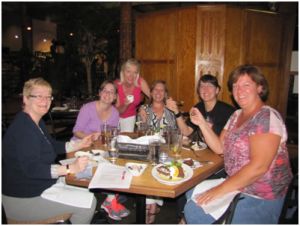
Due to our common purpose of being on the mountain, we had an immediate, unshakeable sisterhood. The bond we had upon arriving deepened the longer we were there, and one of the many things we learned about our small group was how awesome we fit together. Each of us had weaknesses that others had strengths in and vice versa. The experience in and of itself was one of the biggest takeaways I had, simply because I now have a kinship, a sisterhood, with four other writers who I know will always be there to support me and my craft, who I can reach out to and talk about which rhetorical device will work in a particular passage, who I can send a sentence or a paragraph to and know they will help me make it the best it can possibly be (as in a NYT worthy sentence or paragraph).
The Takeaways
One of the many takeaways, other than the experience itself, is that I now know both my personal style and my cognitive style. One of the first tasks we took on was a survey in which we discovered each person’s style. Above all, I have an amiable style, followed closely behind with an analytical style. This means I’m relationship-oriented, strongly committed to others, a team player AND fact-oriented, a planner, an organizer, and at times may appear to be detached because I’m so immersed and focused on a particular task. A close third in personal style is that I’m expressive, outspoken, and spontaneous.
Granted I pretty much knew this, I never truly realized what parts of my personality and style were more dominant. Knowing your style is extremely important in a group setting, and this was the perfect beginning to the Deep Immersion Master Class.
Another takeaway was I got to sit down and not only listen to everyone else’s goal of where they want to be a year from now, but I actually sat down, thought, and decided where I wanted to be a year from now. This is something I hadn’t done before, and I’ll be forever grateful to Margie to having us think and share on these particular goals.
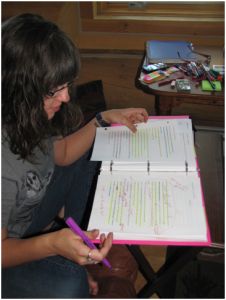
So where do I want to be in a year? I want to be agented (dream agent: Amy Boggs with the Donald Maass Literary agency), I want to enter a few writing contests, I want to have at least two stories drafted and fully polished (though partially will work too), AND, this is a new goal we each decided upon before leaving, I want to attend another Deep Immersion Master Class next year (yup, we’re going back together next year for more!).
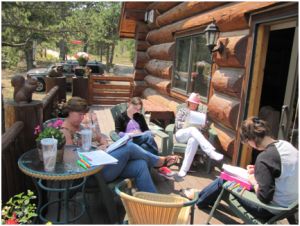
The Lessons
Without giving away too much, here’s the first half of the top ten lessons I learned while in Colorado (trust me, there are many, many more):
1. Opening Promises:
The opening of your story, the first sentence/paragraph, should make a promise to your reader. It needs to promise the reader what they can expect from your style, AND what they can expect from your story. Once you’ve got the promise down, you must, must, must follow through and deliver with the rest of your story.
Here’s my newly polished, pitch-perfect opening paragraph:
When you’re happy and with someone you love, you never hear clocks ticking your life away. But the second they leave you, time snickers and revels in your isolation. I eyed the ghostly white clock hanging above the door with a sneer on my lips. Once, not too long ago, I enjoyed the sound of its ticking, especially when writing and pitch-perfect prose appeared on the page.
2. Opening in the Right Place:
One lesson I learned is that when you think you’ve got your story opening in the right place, nine times out of ten it’s not. And that’s okay, because it can take several a few tries to get it juuuuust right. You not only want to start in a place where your two promises will immediately shine, but you also want to start where the action begins.
Sometimes where you think it starts is actually backstory, or it may be where you think it starts is nothing but deep internalizations. We all know both of these are a BIG no-no, but both can creep up without you knowing it, and the next thing you know, you’re getting comments back from Beta Readers and/or critique partners saying the beginning doesn’t pull them in, so what you do instead cutting, cutting, cutting, and pulling, pulling, pulling, is you add, add, add to hook them in.
What I should have done when I got back those comments is look for my first action/paranormal scene, pull it to the forefront, and immediately fulfill a promise I made to my readers. When Margie showed me where my real beginning was, that meant I had to say goodbye and bury four pages of my original opening! And now I can say with confidence, that I know where and how a story should really start.
3. Transitions Aren’t Just for Scene Breaks:
Let’s say you’re reading a character description and the author goes from describing their face directly to mentioning an ugly scar on the character’s shin. Hmm… without a proper transition between the two, this can trip the reader, especially since when we’re describing a character, we normally go from top to bottom, or vice versa. But if you decide to jump from one important, mesmerizing detail on the face to a noteworthy, ugly detail on a leg, you’ve got to transition the reader for a smooth read.
Here’s an example off the top of my head:
His eyes were dark and silky, jaw sharp and sexy. An ugly scar marked his left shin from knee to ankle.
When you started to picture the character’s face, didn’t you instantly place a scar somewhere along his jaw at first? Exactly. There has to be a transition there to take you from the face, to the legs. Something like this that is so incredibly simple makes a huge difference in the reader’s mind.
With a transition:
His eyes were dark and silky, jaw sharp and sexy. She gave him the once-over and caught sight of his left shin. An ugly red scar, from knee to ankle, protruded from his silky, perfectly pale skin.
Better, isn’t it? Nothing to trip the reader when they begin to picture this character in their mind, right? Keep in mind, though, that this isn’t just for descriptions – it can be used for internalizations, setting descriptions, dialogue, etc. This is now one of the many items on my editing checklist.
4. Find Your Pattern:
We each have a pattern when it comes to our writing style, and discovering that pattern is important. An example would be beginning 9 out of 10 dialogue entries with an action beat. Or following-up 9 out of 10 dialogue entries with internalizations. Another pattern could be tending to start every chapter with straight description, internalization, or dialogue.
Most times we don’t know or see what our pattern is, at least not by ourselves. This is where editing/critique partners and/or Beta Readers come in handy – they can help identify your pattern.
A comment as simple as, “I think this action beat should really go behind the dialogue, or better yet, you really don’t need this action beat at all,” will identify a possible pattern of yours. You can then take this comment, add it to your editing list, and make a pass through your MS intending to look for dialogue entries that follow an action beat. If you have sixty of those throughout your MS, then now you know it’s a pattern and you can work to cut 80% of those action-beat-before-dialogue entries.
Bonus Note: Other than Beta Readers and/or critique/editing partners, another way you can find your pattern, is by taking Margie’s Deep Editing online course. She has an EDITS system she teaches that color codes items such as descriptions/setting, emotional/visceral responses, dialogue, and internalizations (to name a few). By highlighting each of these items on a hard copy of your MS, you can spread your pages on a table (or floor) and easily visualize your pattern. Ex: I begin chapter four of my MS with a sea of GREEN (setting and description). Not good. Now I know I need other colors in there like YELLOW (internalization), BLUE (dialogue), and RED PEN (action or senses).
5. Track Important Story Elements:
Let’s say your story has a paranormal element to it such as mindspeak, or maybe your MC has a pet cat, or story has sprinkles of backstory on every page. These are the types of elements you’ll want to track (and these are only three of the many, many, many types of elements you can track). The best way to do this is:
a. Print your MS in full
b. Decide on the elements you’re going to focus on:
i. Important paranormal elements
ii. Mannerisms (Ex: character pinches the bridge of his nose a lot)
iii. Pets
iv. A character’s snarky attitude
c. Beginning with page one, circle/highlight/underline the element you’re tracking.
d. Once you’ve made a pass through the entire MS, go back and look for those areas where you might’ve forgotten about MC’s dog for about 50 pages, or you might’ve forgotten about the snarkiness of a character during intense or high emotional action scenes.
Tracking these items will you ensure you’re creating a balanced story. Since I write paranormal and urban fantasy, and I have a mindspeaking element that enters the story about halfway through, I need to make sure I’m not forgetting about that ability for 25 pages.
The same can work for a MC that likes to run his fingers through his hair when he’s frustrated, or has eyes that go black when he’s pissed. If you know where these characteristics are, then you can work to make each one as fresh as possible, or better yet, you can remove about 20% of them and replace them with a different, more unique mannerism.
I really, really, really want to encourage everyone to visit Margie’s site, purchase and read and absorb the lecture packets and/or enroll in an online course, then, if possible, attend an Immersion Master Class yourself to fully learn not only these techniques/lessons, but soooo much more! In all her courses, you’ll learn ways to add psychological power to your writing and how to write a page-turner that will keep your readers up until the sun peeks over the horizon!
Before I go, I just want to say thank you again to Jami for having me over today and allowing me to share a small percentage of what I learned in Immersion Master Class.
Because I have so much to share, the second part of this two-part blog post is at The Bookshelf Muse blog today! *smiles* And, as an added bonus, Margie Lawson will be over at my blog today, Muse, Rant, Rave, sharing even more writing technique goodies! *double smiles*
*****
Melinda Collins lives in North Carolina with her freakishly tall husband – AKA: Lurch – two black cats, and drunken muse.
Growing up in the south with an imaginary friend meant Melinda relied on herself for entertainment. Thus, the bug for making up stories – ones that don’t get her into trouble – bit her in the ass in the most gnarly way. She grew to love the paranormal and fantasy worlds while her muse grew to love Grey Goose vodka (she loves him regardless).
When not writing or stuck in a corner listening to a never-ending, story-driven playlist, Melinda can usually be found on Facebook and Twitter.
*****
Awesome information, right? But I still wish I could have fit into Melinda’s suitcase. *sigh*
Don’t forget, Margie is giving away one lecture packet ($22 value) here, another lecture packet at the Part Two of this post (with the rest of the top ten lessons) at The Bookshelf Muse, and an online course ($40 value) at her post at Melinda’s blog. Just leave a comment at each blog to enter. The winners will be decided/announced by Margie around two p.m. (Eastern Time) on Wednesday, September 5th.
Before you pop over to The Bookshelf Muse for Part Two, with more of the experience, takeaways, and lessons from the Margie Lawson Immersion Master Class, or to Margie’s guest post on Melinda’s blog, Melinda wants us to think about the following:
Where do you want to be in a year? What is your style? Do you have the two promises in your opening sentence or paragraph? Do you follow through with your promises? Does your story start in the right place? Do you have a pattern in your writing? Do you have story elements that need to be tracked?
And finally, do you have any questions for Melinda? *smile*

